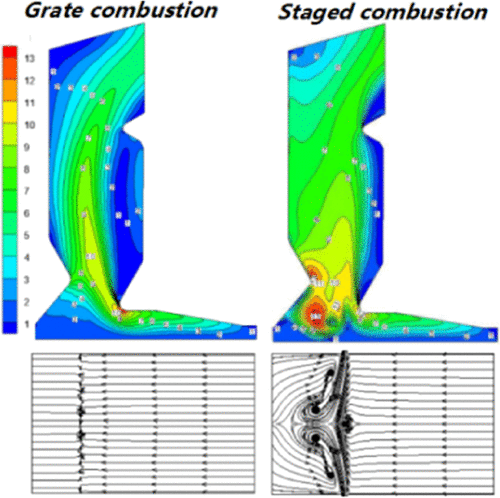Our official English website, www.x-mol.net, welcomes your feedback! (Note: you will need to create a separate account there.)
Aerodynamic Characteristics of a Stoker Furnace with Staged Combustion: Comparison of Cold Modeling Experiments and Numerical Simulations.
ACS Omega ( IF 4.1 ) Pub Date : 2020-07-01 , DOI: 10.1021/acsomega.9b03389 Xinwei Guo 1 , Hao Bai 1 , Zhongxiao Zhang 1 , Juan Yu 2 , Degui Bi 1 , Zhixiang Zhu 2
ACS Omega ( IF 4.1 ) Pub Date : 2020-07-01 , DOI: 10.1021/acsomega.9b03389 Xinwei Guo 1 , Hao Bai 1 , Zhongxiao Zhang 1 , Juan Yu 2 , Degui Bi 1 , Zhixiang Zhu 2
Affiliation

|
A three-dimensional trial bed is established for a staged combustion boiler, and a modeling method based on similarity theory is proposed. The aerodynamic field of the 35 t/h layer combustion—composite combustion chamber—in the stoker boiler with staged combustion was evaluated. Further, a three-dimensional calculation model based on computational fluid dynamics (CFD) was used to simulate the aerodynamic field of the reformed boiler under normal operation, which facilitated convenience in the boiler design. Hot-wire anemometer and other instruments were used for the characteristic test of damper, a velocity field test in the furnace, wall wind test, temperature balance test at the outlet of the furnace, etc., and the law of motion for the flow field in the furnace was obtained. By analyzing the structure of staged combustion, the emission of nitrogen oxides and the combustion stability of a novel layer-fired boiler were studied. The calculated results are in excellent agreement with the experimental data. The results revealed that the combustion efficiency of the boiler and the reduction of nitrogen oxides were significantly improved by the staged combustion technology. There was no erosion on the water wall, and the flow velocity at the outlet of the furnace was uniform. This modeling method exhibits good adaptability to the combustion of stratified combustion boilers and is potentially useful for optimizing furnaces in a variety of applications.
中文翻译:

分段燃烧炉的空气动力学特性:冷建模实验和数值模拟的比较。
建立了分级燃烧锅炉的三维试验台,提出了基于相似理论的建模方法。对分阶段燃烧的combustion煤锅炉中35 t / h层燃烧(复合燃烧室)的空气动力场进行了评估。此外,基于计算流体动力学(CFD)的三维计算模型被用来模拟重整锅炉在正常运行下的空气动力场,这为锅炉设计提供了便利。使用热线风速计和其他仪器进行风门的特性测试,炉子中的速度场测试,壁风测试,炉子出口处的温度平衡测试等,以及流场的运动定律在炉中获得。通过分析分级燃烧的结构,研究了新型层燃锅炉的氮氧化物排放和燃烧稳定性。计算结果与实验数据非常吻合。结果表明,采用分段燃烧技术可以显着提高锅炉的燃烧效率和减少氮氧化物的排放。水冷壁上没有腐蚀,炉子出口处的流速均匀。这种建模方法对分层燃烧锅炉的燃烧显示出良好的适应性,对于在各种应用中优化熔炉具有潜在的实用性。结果表明,采用分段燃烧技术可以显着提高锅炉的燃烧效率和减少氮氧化物的排放。水冷壁没有腐蚀,炉子出口处的流速均匀。这种建模方法对分层燃烧锅炉的燃烧显示出良好的适应性,对于在各种应用中优化熔炉具有潜在的实用性。结果表明,采用分段燃烧技术可以显着提高锅炉的燃烧效率和减少氮氧化物的排放。水冷壁上没有腐蚀,炉子出口处的流速均匀。这种建模方法对分层燃烧锅炉的燃烧显示出良好的适应性,对于在各种应用中优化熔炉具有潜在的实用性。
更新日期:2020-07-14
中文翻译:

分段燃烧炉的空气动力学特性:冷建模实验和数值模拟的比较。
建立了分级燃烧锅炉的三维试验台,提出了基于相似理论的建模方法。对分阶段燃烧的combustion煤锅炉中35 t / h层燃烧(复合燃烧室)的空气动力场进行了评估。此外,基于计算流体动力学(CFD)的三维计算模型被用来模拟重整锅炉在正常运行下的空气动力场,这为锅炉设计提供了便利。使用热线风速计和其他仪器进行风门的特性测试,炉子中的速度场测试,壁风测试,炉子出口处的温度平衡测试等,以及流场的运动定律在炉中获得。通过分析分级燃烧的结构,研究了新型层燃锅炉的氮氧化物排放和燃烧稳定性。计算结果与实验数据非常吻合。结果表明,采用分段燃烧技术可以显着提高锅炉的燃烧效率和减少氮氧化物的排放。水冷壁上没有腐蚀,炉子出口处的流速均匀。这种建模方法对分层燃烧锅炉的燃烧显示出良好的适应性,对于在各种应用中优化熔炉具有潜在的实用性。结果表明,采用分段燃烧技术可以显着提高锅炉的燃烧效率和减少氮氧化物的排放。水冷壁没有腐蚀,炉子出口处的流速均匀。这种建模方法对分层燃烧锅炉的燃烧显示出良好的适应性,对于在各种应用中优化熔炉具有潜在的实用性。结果表明,采用分段燃烧技术可以显着提高锅炉的燃烧效率和减少氮氧化物的排放。水冷壁上没有腐蚀,炉子出口处的流速均匀。这种建模方法对分层燃烧锅炉的燃烧显示出良好的适应性,对于在各种应用中优化熔炉具有潜在的实用性。


























 京公网安备 11010802027423号
京公网安备 11010802027423号